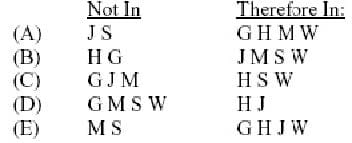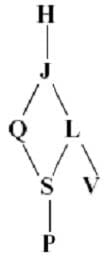Exam Details
Exam Code
:LSAT-TESTExam Name
:Law School Admission Test: Logical Reasoning, Reading Comprehension, Analytical ReasoningCertification
:LSAC CertificationsVendor
:LSACTotal Questions
:746 Q&AsLast Updated
:Aug 07, 2025
LSAC LSAC Certifications LSAT-TEST Questions & Answers
-
Question 351:
Bird-watchers explore a forest to see which of the following six kinds of birds -- grosbeak, harrier, jay, martin, shrike, wren -- it contains. The findings are consistent with the following conditions:
If harriers are in the forest, then grosbeaks are not. If jays, martins, or both are in the forest, then so are harriers If wrens are in the forest, then so are grosbeaks If jays are not in the forest, then shrikes are
Which one of the following is the maximum number of the six kinds of birds the forest could contain?
A. two
B. three
C. four
D. five
E. six
-
Question 352:
Bird-watchers explore a forest to see which of the following six kinds of birds -- grosbeak, harrier, jay, martin, shrike, wren -- it contains. The findings are consistent with the following conditions:
If harriers are in the forest, then grosbeaks are not. If jays, martins, or both are in the forest, then so are harriers If wrens are in the forest, then so are grosbeaks If jays are not in the forest, then shrikes are
If both martins and harriers are in the forest, then which one of the following must be true?
A. Shrikes are the only other birds in the forest.
B. Jays are the only other birds in the forest.
C. The forest contains neither jays nor shrikes.
D. There are at least two other kinds of birds in the forest.
E. There are at most two other kinds of birds in the forest.
-
Question 353:
Bird-watchers explore a forest to see which of the following six kinds of birds -- grosbeak, harrier, jay, martin, shrike, wren -- it contains. The findings are consistent with the following conditions:
If harriers are in the forest, then grosbeaks are not. If jays, martins, or both are in the forest, then so are harriers If wrens are in the forest, then so are grosbeaks If jays are not in the forest, then shrikes are Which one of the following could be a complete and accurate list of the birds NOT in the forest?
A. jays, shrikes
B. harriers, grosbeaks
C. grosbeaks, jays, martins
D. grosbeaks, martins, shrikes, wrens
E. martins, shrikes
-
Question 354:
Each of seven television programs -- H, J, L, P, Q, S, V -- is assigned a different rank: from first through
seventh (from most popular to least popular). The ranking is consistent with the following conditions:
J and L are each less popular than H.
J is more popular than Q.
S and V are each less popular than L.
P and S are each less popular than Q.
S is not seventh.
If Q is more popular than L, then each of the following must be true of the ranking EXCEPT:
A. H is first.
B. L is fourth.
C. V is not fourth.
D. J is not third.
E. Q is third
-
Question 355:
Each of seven television programs -- H, J, L, P, Q, S, V -- is assigned a different rank: from first through
seventh (from most popular to least popular). The ranking is consistent with the following conditions:
J and L are each less popular than H.
J is more popular than Q.
S and V are each less popular than L.
P and S are each less popular than Q.
S is not seventh.
Which one of the following programs CANNOT be ranked third?
A. L
B. J
C. Q
D. V
E. p
-
Question 356:
Each of seven television programs -- H, J, L, P, Q, S, V -- is assigned a different rank: from first through
seventh (from most popular to least popular). The ranking is consistent with the following conditions:
J and L are each less popular than H.
J is more popular than Q.
S and V are each less popular than L.
P and S are each less popular than Q.
S is not seventh.
If V is more popular than Q and J is less popular than L, then which one of the following could be true of the ranking?
A. P is more popular than S.
B. S is more popular than V.
C. P is more popular than L.
D. J is more popular than V.
E. Q is more popular than V.
-
Question 357:
Each of seven television programs -- H, J, L, P, Q, S, V -- is assigned a different rank: from first through seventh (from most popular to least popular). The ranking is consistent with the following conditions:
J and L are each less popular than H.
J is more popular than Q.
S and V are each less popular than L.
P and S are each less popular than Q.
S is not seventh.
Which one of the following could be the order of the programs, from most popular to least popular?
A. J, H,L, Q, V, S,P
B. H, L, Q, J, S, P, V
C. H, J, Q,L, S.V.P
D. H, J, V,L, Q, S,P
E. H, L, V, J, Q, P, S
-
Question 358:
Each of seven television programs--H, J, L, P, Q, S, V--is assigned a different rank: from first through
seventh (from most popular to least popular). The ranking is consistent with the following conditions:
J and L are each less popular than H.
J is more popular than Q.
S and V are each less popular than L.
P and S are each less popular than Q.
S is not seventh.
If J is more popular than L, and S is more popular than P, then which one of the following must be true of
the ranking?
A. J is second.
B. J is third.
C. L is third.
D. Q is third.
E. P is seventh
-
Question 359:
We are in a new industrial revolution that requires management trainees to develop "action learning" from real experience within business and industry, rather than getting tied up with theory and academia. Business schools seem unable, on their own, to tear themselves away from their largely academic roots and move closer to the realities of today's business and industry; too often, trainees in business schools find themselves studying hypothetical cases instead of real ones. Furthermore, business schools have been slow to respond to the needs of business. Therefore, business schools should allow business executives to set curricula for management trainees that could then be taught by academics.
The argument relies on which one of the following assumptions?
A. Academics in business schools have no practical business experience that is valuable.
B. Academics in business schools deal only with hypothetical situations in their business case studies.
C. Academics are not capable of teaching curricula suitable for relevant management training.
D. Academic training outside of business schools is more responsive to the needs of business than is training within business schools.
E. Today's business executives have valuable insight into business that academics in business schools do not have.
-
Question 360:
Maria won this year's local sailboat race by beating Sue, the winner in each of the four previous years. We can conclude from this that Maria trained hard.
The conclusion follows logically if which one of the following is assumed?
A. Sue did not train as hard as Maria trained.
B. If Maria trained hard, she would win the sailboat race.
C. Maria could beat a four-time winner only if she trained hard.
D. If Sue trained hard, she would win the sailboat race.
E. Sue is usually a faster sailboat racer than Maria.
Tips on How to Prepare for the Exams
Nowadays, the certification exams become more and more important and required by more and more enterprises when applying for a job. But how to prepare for the exam effectively? How to prepare for the exam in a short time with less efforts? How to get a ideal result and how to find the most reliable resources? Here on Vcedump.com, you will find all the answers. Vcedump.com provide not only LSAC exam questions, answers and explanations but also complete assistance on your exam preparation and certification application. If you are confused on your LSAT-TEST exam preparations and LSAC certification application, do not hesitate to visit our Vcedump.com to find your solutions here.

